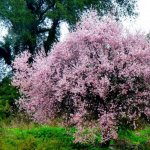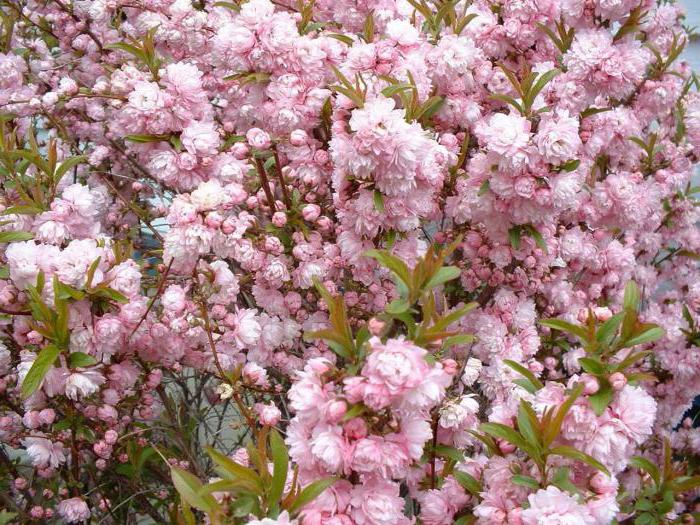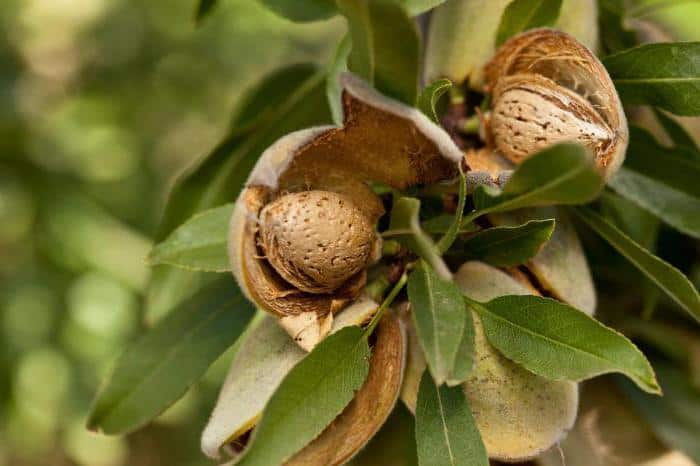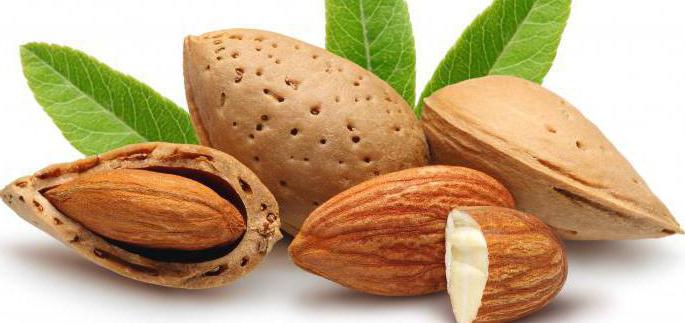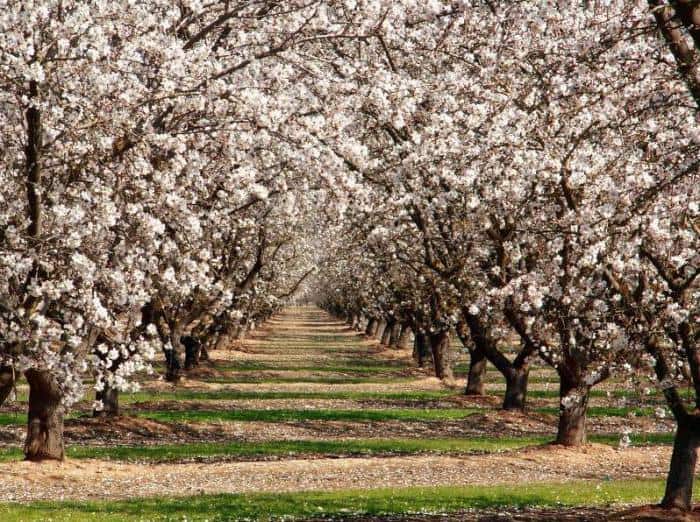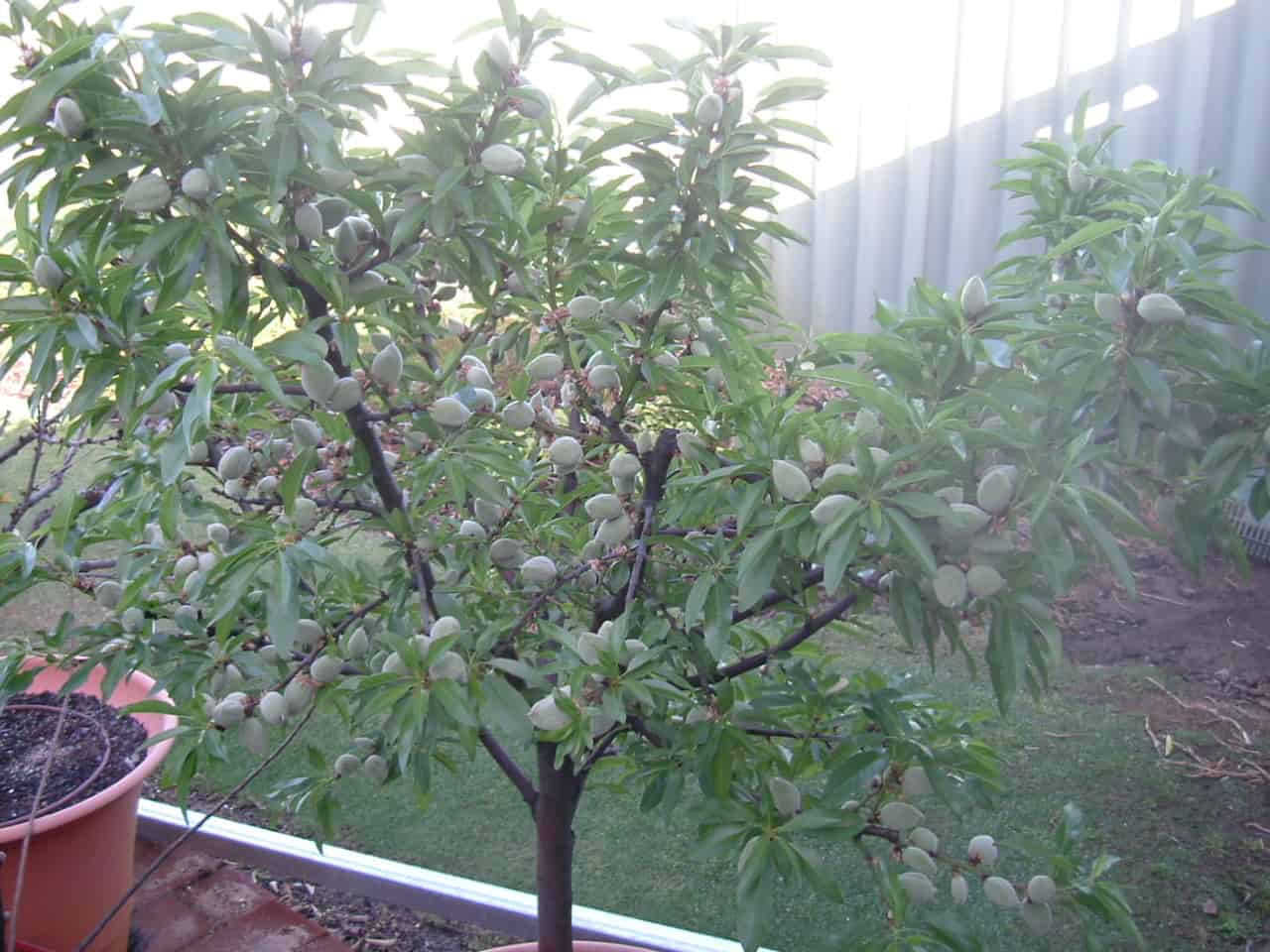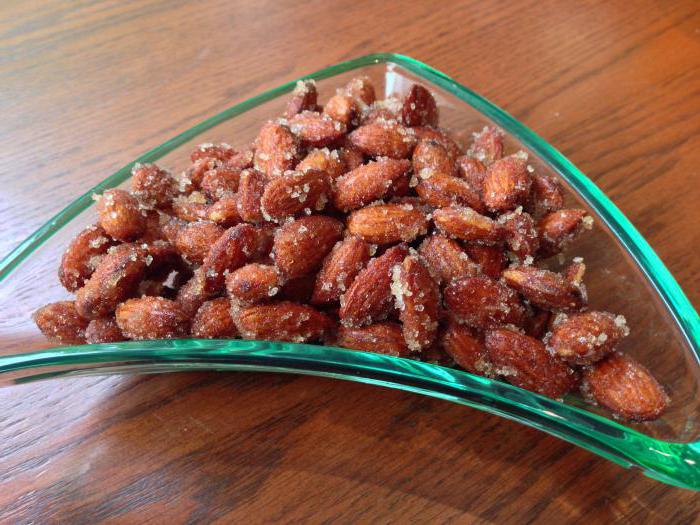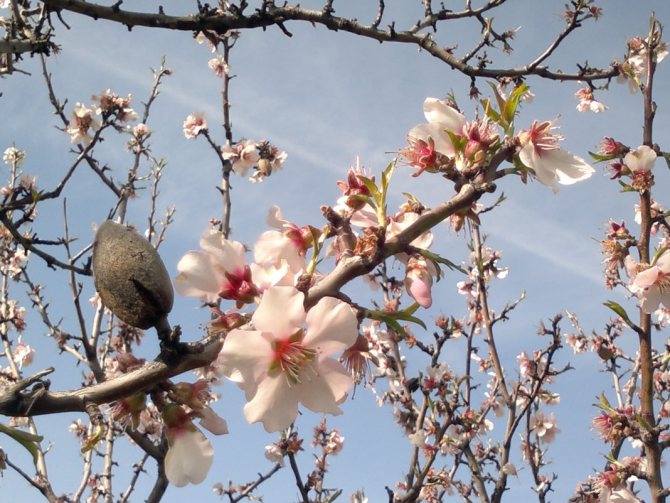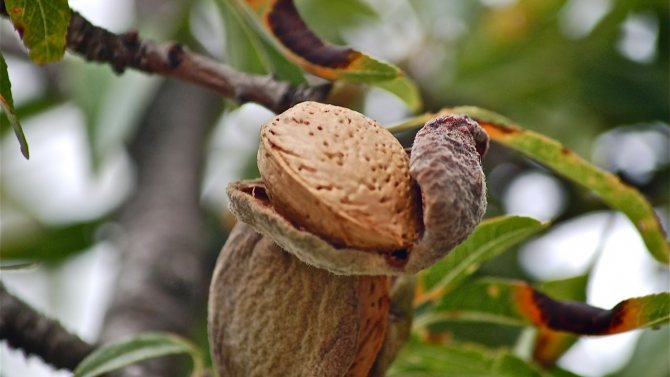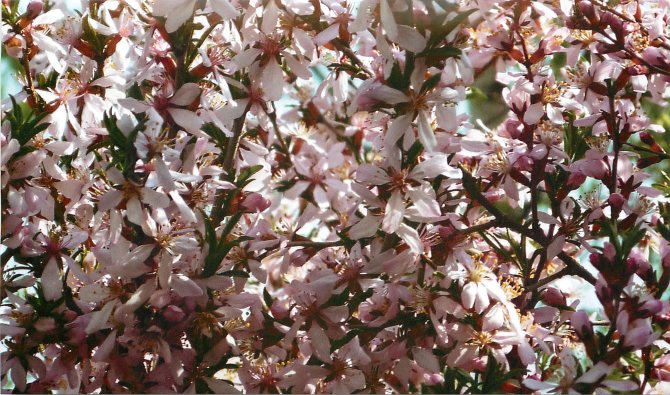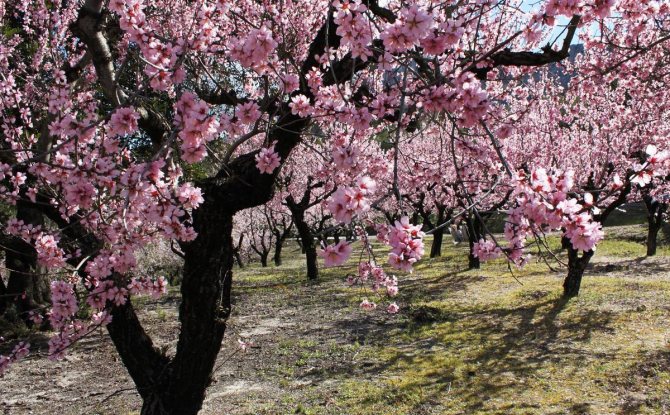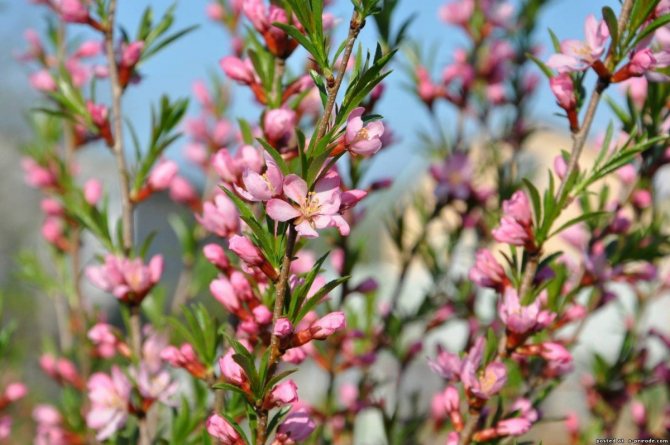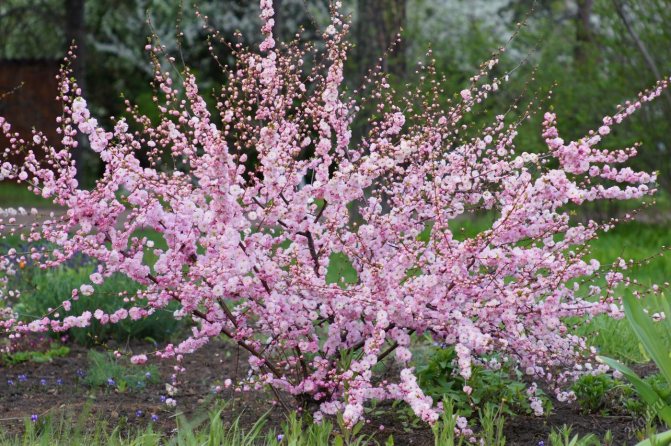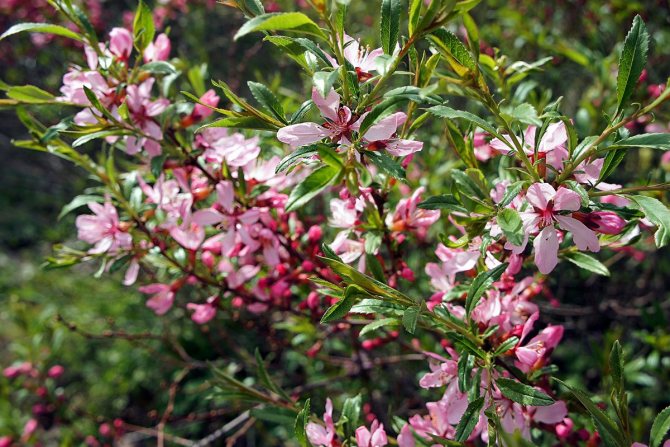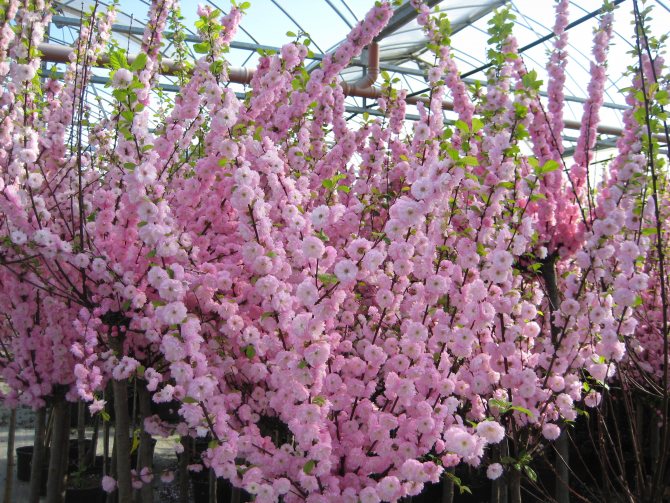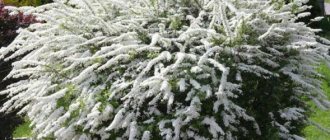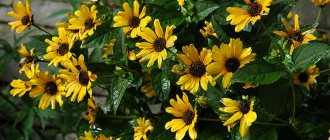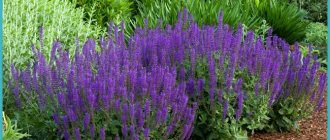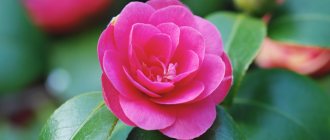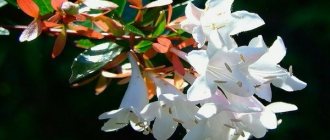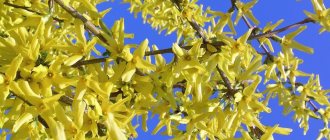Almonds not only taste great, but they are packed with nutrients as well. That is why many gardeners want to plant it on their site and harvest useful nuts. The natural habitat of the plant is countries with hot summers and mild winters. In order to grow an almond tree in unusual conditions for it, you need to know how to choose the right variety, study the planting technology and the principles of further care. If you approach the process with all responsibility, then a few years after planting, you can feast on delicious fruits.
Botanical description
Wild almonds and cultivated almonds exist in nature. Wild plant nuts are bitter, and therefore it is better to plant varietal almonds in the garden, which have a sweet fruit taste.
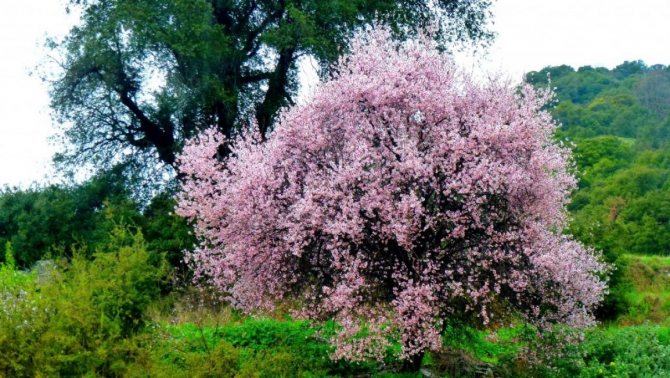
The tree is striking in its beauty
An average plant has the following characteristics:
- tree height - from 4 to 6-8 meters
- the root system consists of 5 skeletal roots, which are able to penetrate to great depths, providing the tree with water from underground sources. Therefore, almonds calmly belong to an arid climate.
- almond shoots are divided into two types - shortened and elongated
- large almond flowers - up to 2.5 cm in diameter
- flowering begins in early spring - April or even March. Moreover, flowering occurs before the first leaves bloom on the almonds.
- almond nuts are from 2.5 to 3.5 cm in length, after drying the seeds are easily removed from the pericarp
- first fruiting begins in the fifth, with good care in the fourth year of life. After another five to seven years, the tree enters full fruiting. The minimum period when a tree bears fruit is 30 years.
- there is also an ornamental almond that is bush-shaped. It is very beautiful - the whole bush is sprinkled with gentle or bright pink flowers
Due to its strong sweet aroma, almonds become a honey plant during the flowering period. This smell attracts many bees, which pollinate both almonds and other plants in the garden.
For many centuries, this beautifully flowering and prolific plant has grown in the Mediterranean and Central Asia. Now planting of almonds has spread to several continents, ranging from Europe, China and ending with the United States. In the wild, almonds grow in groups at an altitude of up to 1.6 km. In Russia, the almond shrub is widespread in the southern regions.
Reproduction of almonds
When propagating almonds, you need to know some features.
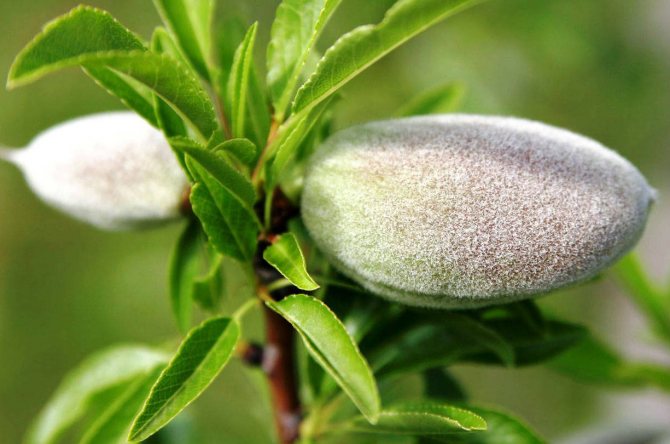

The fact is that specific almonds can be obtained by growing seeds, and varietal almonds only by layering, shoots or grafting.
Growing almonds from seeds
Almond seeds are sown in spring or autumn. When sowing in spring, the seeds must be prepared in advance.
To do this, they need to be placed in a cool room with a low positive temperature.
Ideal conditions for this are the vegetable shelf in the refrigerator. It is necessary to keep the seeds in this way for at least 4 months.


In the soil, beards are made with a depth of 7-10 cm.
The distance between the seeds is at least 10-13 cm.
In this case, the distance between the furrows is left 50 cm.
As soon as the first shoots appear, you need to provide them with proper care.
It consists in regular watering, weeding and loosening the soil to saturate it with oxygen.
When the seedling reaches a height of 50 cm, and its thickness is 1 cm, it is necessary to cut off all branches growing at a height of up to 10 cm into a ring.
Pay attention to how to do this correctly, as many gardeners often make mistakes when doing this. It will be possible to plant almonds as soon as the seedling gets sick and adapts to new conditions.
Almond grafting
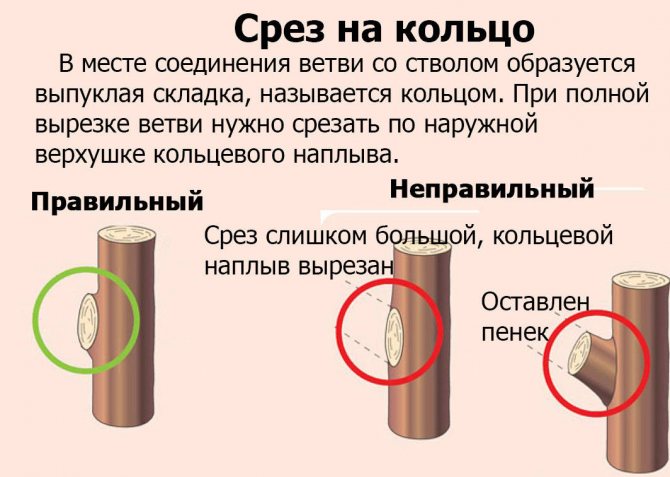

It is recommended to choose frost-resistant rootstocks for grafting. Best of all, almonds grow on rootstocks of plum, bird cherry, cherry plum.
Pay attention to the scion. It should be straight, with well-developed stems with eyes.
It is necessary to remove all the leaves with the pruning shears, leave only the petioles 1 cm long. As for the time, it is possible to inoculate during the period of sap flow. It happens in spring or August.
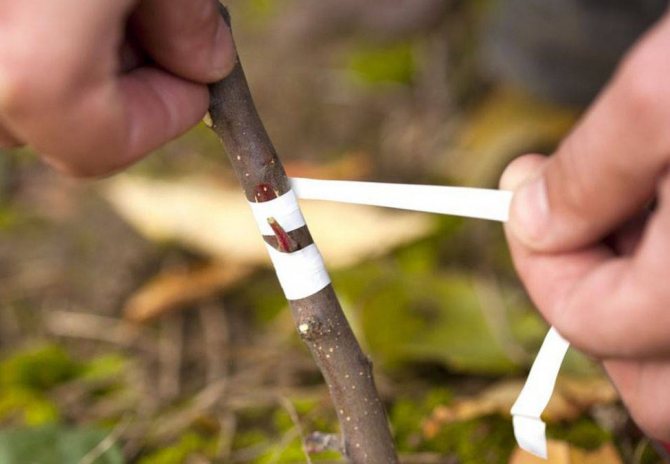

Grafting process:
- Dust and dirt are removed from the stock and rubbed with a damp cloth.
- A T-shaped incision is made slightly above the root collar. For this, there is a special budding knife.
- The neatly cut bark is pushed apart.
- Cut off the scion from the scion.
- Next, the flap is placed in the incision in such a way that it completely enters there. That is why it is better not to make the flap too long.
- After that, the cut edges of the bark are pressed against the flap and fixed with adhesive tape, plaster.
With the spring grafting, after 15 days, the petiole from the bud falls off by itself. If the vaccination was in August, then the tape or plaster is left until next fall.
Cuttings
For propagation of almonds by cuttings, planting material is harvested in the first month of summer.


Semi-lignified cuttings should have at least 2 nodes, the length of the petioles varying from 15 to 20 cm. The planting material is placed in the ground.
Rooting occurs in 20-30 days. As a rule, 85-100% of cuttings take root.
How to propagate by growth
To increase the amount of root growth, it is necessary to do strong pruning.
In order for the offspring to take root well, it must have a developed root system. As a rule, this happens in the second year of development.
Layers
For reproduction by layering, it is necessary to dig a trench. Next, mark a long stem on the bottom, fix it with pins.
Sprinkle the top with earth. Throughout the entire period when the roots will develop, it is necessary to regularly water the trench. Rooting lasts for 1 year.
Fruits and their uses
The plant is valuable not only for its decorative qualities, but also for its tasty and healthy fruits - almonds. The fruits usually ripen in summer (June-July), outwardly they look like pubescent drupes, covered with a gray-green pile. Inside a thin shell there is a seed (nut) up to 2 cm in size, having a rounded shape on one side and a sharp tip on the other.
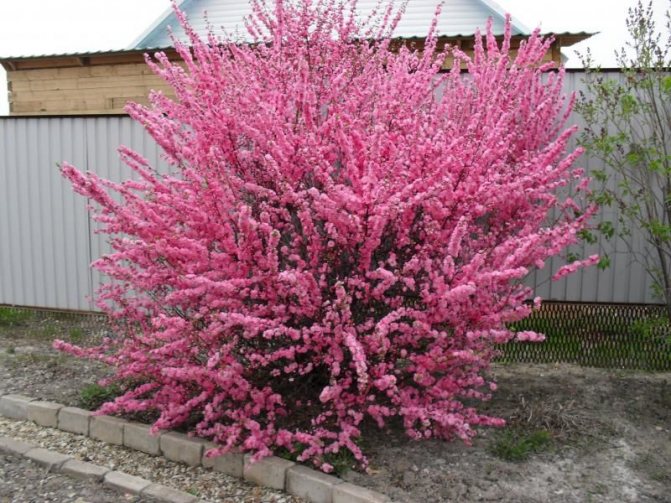

Almonds are widely used in cosmetology and medicine, they are used in the menu of therapeutic diets and for weight loss. In cooking, the fruit is very popular for making cakes, pastries and other desserts. Almonds are used in the production of alcoholic beverages.
Any fruit that grows on the ground has a large number of positive and negative properties. For example, almonds are recommended for:
- blood purification;
- removing bile;
- increasing potency;
- calming the nerves.
Almond fruits can cause allergies
Milk is also produced from this nut, which is excellent for cleansing and softening the skin.
Also, doctors were able to prove that it is almonds that perfectly stimulate the work of the human brain.
But this fruit can also harm the human body, for example:
- causes allergies;
- the nut contains a lot of fat and calories;
- the fetus is poorly digested by the body.
Many gardeners know that the almond bush is not only beautiful when it blooms, but also smells very good. To all this, you can also add the divine taste of the nuts themselves.
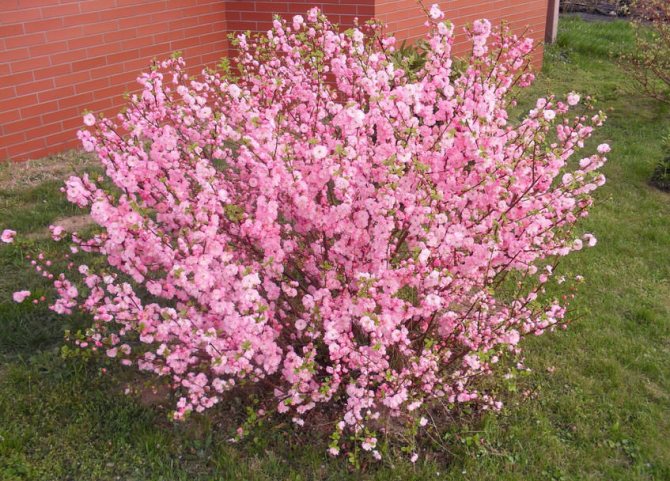

But in order to make the purchase of this nut for planting, it is recommended to contact a specialized store.
Today, the cost of almonds fluctuates. This is due to the fact that there is some financial instability on the territory of our country. But, despite this, gardeners are increasingly planting almond bushes on their plots.
Harvesting and storage
Almond fruits are dry and velvety to the touch drupes with a leathery and rather fleshy green pericarp. After drying, the pulp is easy to separate from the edible part of the oval seed with a large number of grooves. The first crop ripens on average in the fifth or sixth year of growing the crop, but the maximum number of fruits will be removed no earlier than after 10-12 years (the maximum fruiting period is 50 years).
Depending on the selected variety, harvesting begins at the end of July, in August or early September, but it is best to focus on the state of the outer shell of the almond: as soon as it begins to crack, you can remove the fruits.
Find out what happens if you overeat almonds.
Further, the nuts are cleaned of the inedible outer shell (green skin), and then dried for several days in a dry and well-ventilated room. The dried crop can be poured into fabric bags for further storage, or you can remove the middle and additionally dry it. Peeled and well-drained almonds will last much longer.
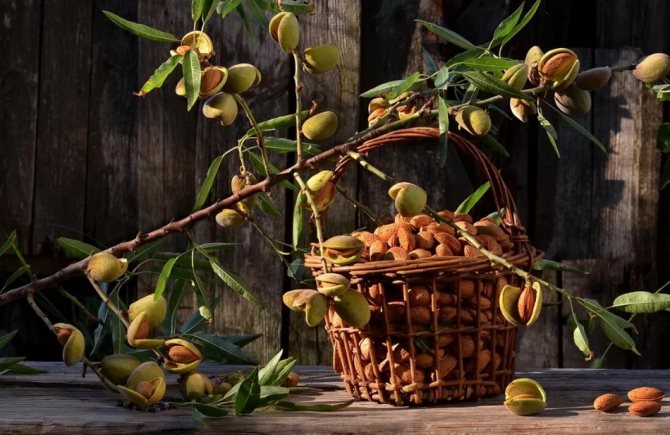

Choosing a site for planting
Before planting an almond plant on your site, you should choose a suitable place for it. For a plant to be healthy and bloom abundantly, it needs a space protected from wind and drafts, and a lot of sun. Almonds do not tolerate shade, so the southern part of the site, which is well lit all day, will be optimal.
The shrub does not have any special requirements for the soil, however, it prefers sandy loam or light loamy soils that have a good supply of nutrition (preferably fertilized with compost). Groundwater should not come close to its roots: if the site is flooded on clay soil, the plant will die. The soil should be non-acidic, pH = 4.5-7.5, otherwise it is better to neutralize it by adding lime.
Given that almonds grow very tall, they should be planted where there is room. If you plant it too close to other plants, then over time, its crown will shade all the space around.
Also, when choosing a place for planting, it must be borne in mind that this plant bears fruit only with cross-pollination. Therefore, at least two or three more almond trees, pollinating varieties, will have to be planted around the first almond. If the neighbors already have almonds growing, the plants still do not get pollinated, since they must be very close to each other.
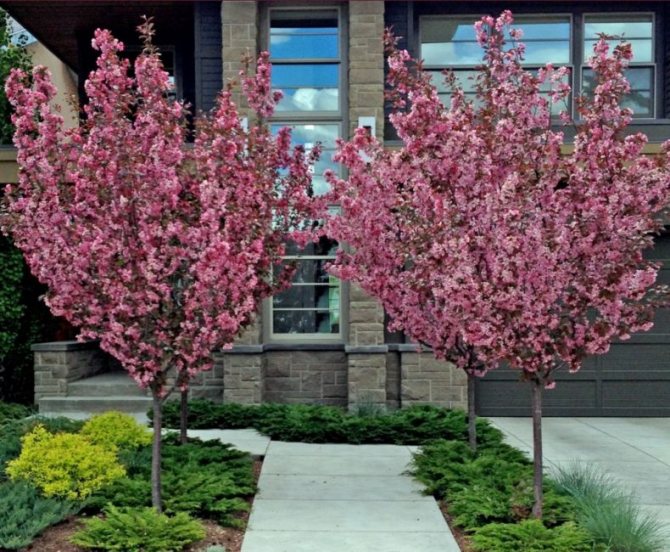

Arrangement of trees
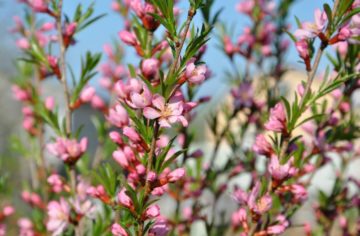

The best place to plant a tree is a sunny (partial shade is allowed), protected from winds and drafts. If the gardener ventured to plant almonds in the shade of tall buildings or trees, the tree's growth process will be slowed down, and the productivity of the plant will be low.
1 Suitable - black earth, loam or sandy soil. Well air and water permeable, with deep groundwater. The plant thrives on calcareous soils with a PH of 7.7.
2 Unsuitable - acidic or saline, chloride or with a high groundwater table.
You also need to make sure that the tree fulfills its decorative role - why hide such beauty from eyes in the far corner of the garden? A group of 3-5 plants will look great along the fence, which will also protect the trees from the wind.
Landscape designers love decorative almonds for the beauty of the plant during flowering.


It looks great in single and group plantings.
The view of this plant is effective in the vicinity of low bushes with red leaves.
Almond bush on the plot
The shrub will decorate the green lawn, it will look elegant at the entrance to the house.
Diversifies the look of rocky gardens.
Ornamental almond ball hedges will create a beautiful view.
Landing on the slopes will not only ennoble the landscape, but also serve to strengthen the soil from crumbling.
Read more: When to plant cucumber seedlings in open ground and a greenhouse, photo and video
Almonds live up to their name: decorative. It is impossible to resist the lush pink cloud of its blossoming branches. Popularity among summer residents and professional designers is also associated with easy care and relative ease of growing.
But planting and caring for an ornamental almond shrub still requires compliance with certain rules, the implementation of which will allow you to enjoy the wonderful aroma and triumph of delicate colors.
Rosenmund
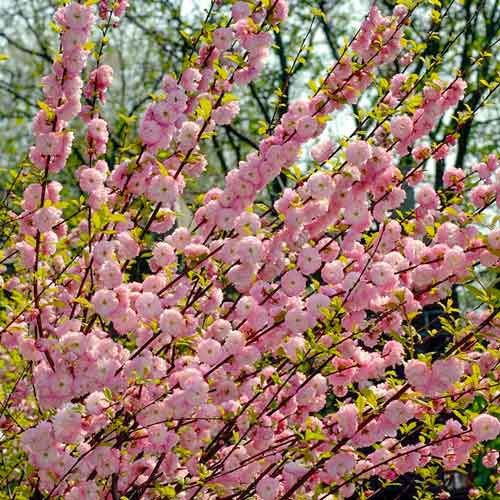

Grows up to 3 meters
Bloom from May to June
Decorative plant
A fast-growing bush, up to 3 m high and wide. It has a spreading crown and straight branches. Leaves are dark green in color with jagged edges. In autumn they turn yellow, bloom after flowering.
Rosenmund blooms in May. The flowers are large, bright pink in color, sit on short stalks, tightly pressed together along the branches. The Rosenmund plant has a long flowering period (over 3 weeks).
Planting in spring and autumn
Experts recommend planting this tree in the fall - at the end of November, they say, in this case it will take root better. Planting is possible even in the first winter months. But, if it is spring outside, early March, and you have an almond sapling in your hands, then there is no need to wait until autumn with planting.
10-14 days before purchasing a seedling (or better - from autumn for spring planting, or from spring for autumn), you need to prepare a planting pit. This is done so that the earth settles, and the plant does not sink too deep after planting.
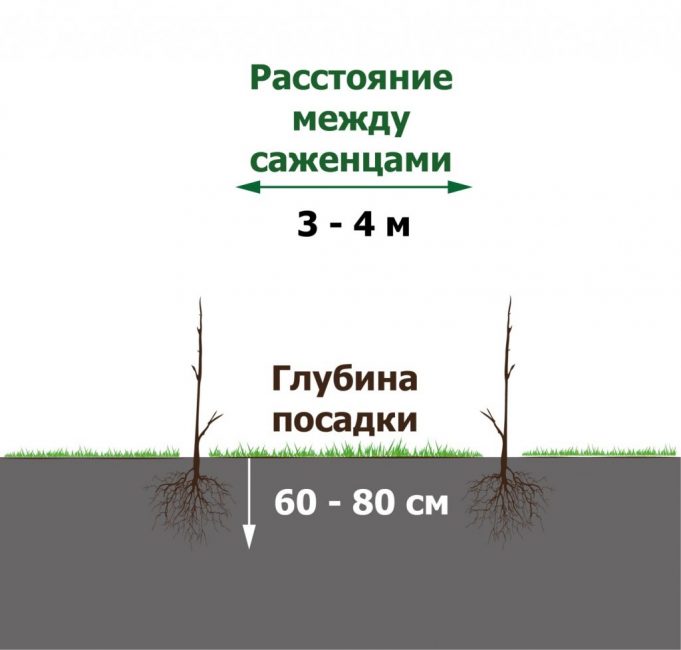

There must be enough space between the plants
The diameter of the planting hole is 50-70 cm, and its depth is about 60 cm. If you plan to plant several plants at the same time, you need to make sure that the distance between the holes is at least 3 meters, and between the rows - at least 5.5 meters.
At the bottom of the pit, it is advisable to lay out a drainage layer from any available materials - broken brick after construction, expanded clay, gravel. Sprinkle the drainage on top with sand. The land taken out of the pit must be enriched:
- Fertile soil is being prepared - sand (1 part), humus or compost (2 parts), leaf (or ordinary) soil (3 parts).
- Another 5 or 6 kg of humus or compost is added to the soil.
- 500 g of superphosphate is added to the mixture.
- If the soil on the site is too acidic for almonds, 300 g of dolomite flour or lime can be added to the planting mixture to even out the acid-base balance.
This soil mixture is poured into the planting hole, forming a small mound from it in the middle of the hole. Part of the mixture must be left so that there is something to sprinkle the roots of the seedling.
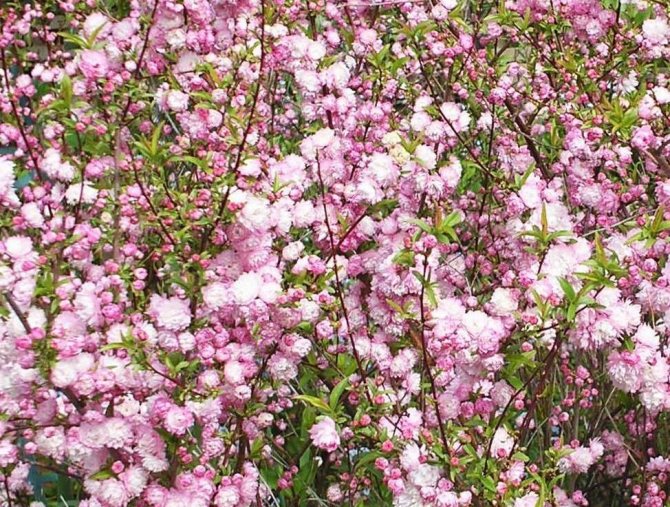

It is also advisable to drive in a peg that will rise above the ground by at least 50 cm.
Landing technique
After two weeks have passed since the pit was prepared, the almonds can be planted. The optimum age for an almond seedling is 1 year. It should look healthy and have a good and intact root system.
Before starting the procedure, the roots of the tree must be soaked in water. And then dip it into an aqueous solution of clay, which has the consistency of thick sour cream.


Excellent plant specimen
The seedling is installed on a mound, taking into account that the root collar is slightly above ground level, and its roots are covered with soil mixture. The tree needs to be shaken gently from time to time so that all air pockets between the roots are filled with earth.
After planting, the earth is compacted and watered with a bucket of water. In order for the liquid not to spread over the area, a low earthen rampart can be made around the tree, and water can be poured into the circle.
When the water is absorbed, you need to tie the seedling to a peg, and mulch the ground in the near-trunk circle by 5 cm.For this purpose, you can use compost, since it will perform an additional function of feeding the plant. The main thing is to make sure that the mulch does not touch the tree trunk, there should be a couple of centimeters of empty space around it.
Variety of varieties
Common almonds have many varieties, some of them grow in the form of trees (up to 6 m in height), others - shrubs.
Almond plants planted in central Russia have good frost resistance, however, due to early flowering, many buds can freeze slightly, which affects the size of the crop. To get guaranteed good fruits, experts recommend planting varieties that have a long period of bud formation and later flowering.
The most suitable frost-resistant varieties:
- "Nikitsky" is a shrub up to 5 m high, has large fruits and a long dormant period, good yield, suitable for growing in any regions of Russia, blooms in mid-April, but pollination requires planting plants near it with the same flowering period.
- "Primorskiy" - height up to 3.5 m, blooms in April, fruits - an elongated shape with a rounded base and a sharp tip, a large harvest ripens by mid-November.
- "Dessert" - has a dense spherical crown, height up to 4.5 m, flowering occurs in April, the fruits are oval in shape with a slightly pointed tip.
Walnut or drupe?
The first fruits appear 4-5 years after planting; in general, the tree can bear fruit up to 50 years.
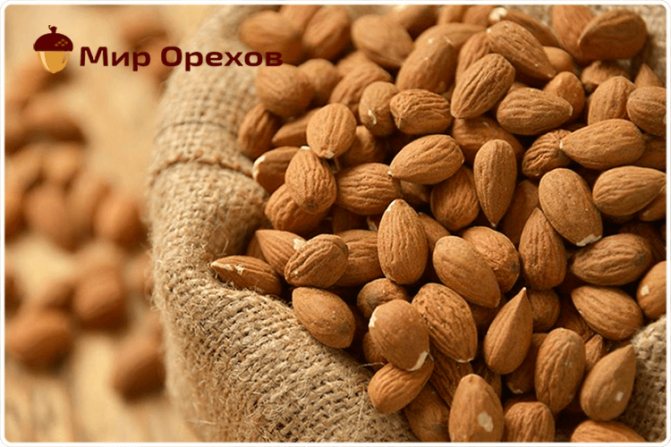

Many ordinary people believe that almonds are a nut, but this is fundamentally wrong.
Ripe almonds resemble a dried plum, only the pericarp is not edible, the contents of the bone are eaten, that is, the edible fruit is a drupe.
What is the care


The tree needs care, especially in the first year of life.
If there is very little time to take care of the tree, you can limit yourself to pruning and warming for the winter. But then the almonds will not grow very quickly and you can not hope for a big harvest.
If you draw up a plan for caring for the plant and carry it out in accordance with the peculiarities of the agricultural technology of this culture, then it will generously thank the owner with delicious fruits.
- watering
- loosening the soil
- crown pruning
- weed, disease and pest control
- top dressing with organic and mineral fertilizers
- shelter for the winter (for young plants, even winter-hardy varieties, it is mandatory)
If you want to get your own free almond seedlings, you will have to master breeding methods. But in this regard, there is nothing difficult, even an inexperienced gardener can handle it. But the seedlings can be planted in their area to ensure pollination, distributed to relatives and friends, or sold - young almond trees are several times more expensive than many other fruit trees.
Watering and loosening
The first watering and loosening of the soil of the near-stem kuga is carried out at the very beginning of March - these procedures open the new season. As soon as the ground thaws, you can water the plants at the rate of 1 bucket / 1 tree. No more pouring is needed, since excessive moisture leads to inevitable decay of the root collar.
After moistening, the soil in the trunk circle is loosened. Loosening improves the air permeability of the soil.The first time it is done to a depth of 10-12 cm, and after each subsequent watering during the season - to a depth of 8-10 cm.
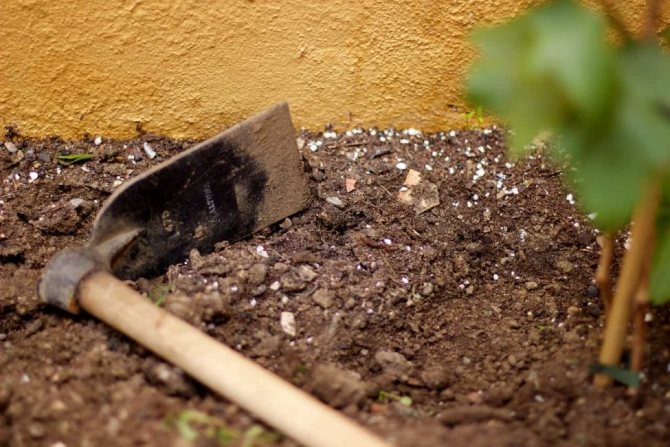

Loosening is a desirable procedure in holistic wood care
If you don’t want to do loosening or you don’t have time for it, then mulch the soil around the tree with some durable material. Pebbles or, in extreme cases, tied bundles of hay or straw will do. In this case, the soil will dry out less, will not require constant processing, and will not be covered with weeds.
You can water the tree over mulch. It will have to be removed only when fertilizers are applied.
Read more: Bellarosa potatoes characteristics and description of the variety features of planting, cultivation and care taste
All other watering during the season is carried out as the soil dries out to a depth of 1.5 cm. If the tree grows on sandy soil, then this will happen more often than if almonds are planted on clay or loamy soil. For each watering, you will need 1 bucket of sun-settled water.
Watering recommendations apply to more or less mature trees. In the first year, when the seedling is still young and not adapted to the external environment, it will have to be watered much more often - once every 1.5-2 weeks.
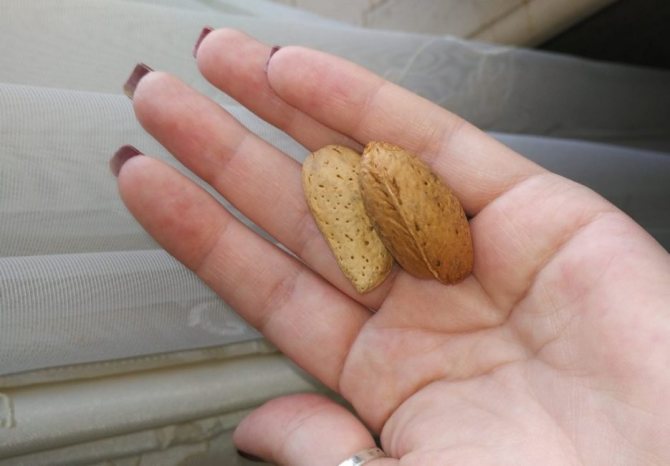

Such fruits can be obtained only by providing the tree with regular moisture.
When the grower does not have constant access to water, and watering is carried out only through natural rainfall, almonds are likely to survive. Indeed, in nature, it is a drought-resistant tree. But the lack of moisture leads to inhibition of the growth of the seedling.
Due to lack of fluid, almond leaves are dehydrated. When the moisture content drops to 53%, the tree sheds most of its foliage already at the beginning of summer.
The lack of foliage causes the growth of new shoots to stop. All this in combination leads to an almost complete loss of the harvest this year, and the future too. After all, generative buds also practically do not develop.
If there is practically no opportunity to regularly feed the plant with water, organize, at least, spring and autumn water-charging irrigation! To do this, you can pre-accumulate rainwater in large containers. And in the spring, collect the snow before the onset of heat and wait for it to melt.
Watering and caring for the shrub
Ornamental almonds are distinguished by many advantages, among which are rapid growth, unpretentiousness, good adaptation to urban conditions, they are not afraid of drought and are a valuable melliferous crop.
The list of care measures includes:
- regular watering (no more than 1 time per week), since the plant does not like stagnant water;
- mandatory loosening of the soil after watering (to a depth of 7 cm);
- removing weeds around the plant;
- top dressing in the spring (mullein or manure), in the fall (superphosphate or potassium);
- ensuring safe wintering - covering the seedlings with straw, foliage, etc., the layer height is at least 15 cm, adult bushes can be covered.
Crown pruning
Almond crown pruning is a must if the grower expects a high yield. The fact is that the thickened crown shades itself, that is, the shoots inside the crown and at the base of the skeletal branches. With a lack of light, these shoots simply dry out.
As a result, the crop can be harvested only where the branches are well lit - at the ends of the shoots along the periphery of the crown.
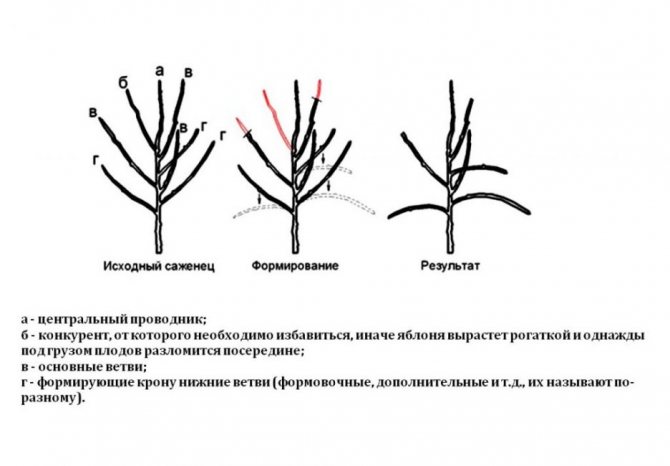

This pruning option is suitable not only for apple trees, but also for our tree.
Pruning begins from the second year of the plant's life in the garden. First, after wintering, almonds may need sanitary pruning, which removes all "bad" shoots - broken, diseased, dry, frozen. At the end of the season, a similar sanitary pruning is done on all damaged or infected shoots.
Almonds respond well to pruning, including the gardener cuts the shoots into bouquets in the spring.
Secondly, the most important pruning is formative. It is necessary to form all skeletal branches in the second year of the plant's life. Or at least try to do it.
Crown formation
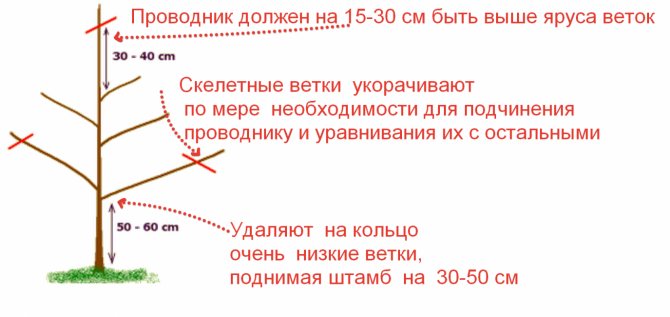

Crown formation rules
The formation of the crown is as follows:
- The gardener determines for himself the optimal height of the trunk - that is, the height from which the branches begin to grow. All shoots that are below must be cut into a ring, that is, without leaving a hemp.
- Of all the low-lying shoots, the first skeletal branch in terms of number and height is selected. For this role, you need to choose the strongest and most developed shoot from the lower ones.
- The second skeletal branch is the one that is located 10-20 cm higher than the first and directed in the opposite direction.
- The third skeletal branch is one that grows 10-20 cm higher than the second and is directed perpendicularly to the previous two.
- All other branches that are in the zone of the three skeletal branches are cut into a ring.
- To control the growth of the tree upward, you can shorten the center conductor. It should rise 50-60 cm above the last branch.
In the future, the gardener must ensure that the young shoots that will appear as the tree grows do not thicken the space inside the crown. And also so that they do not compete with the main ones, that is, they are not stronger and more developed than the skeletal ones and the conductor itself.
When cutting thick branches, the cutting site must be treated with garden varnish to help the plant recover.
Disease and Pest Control
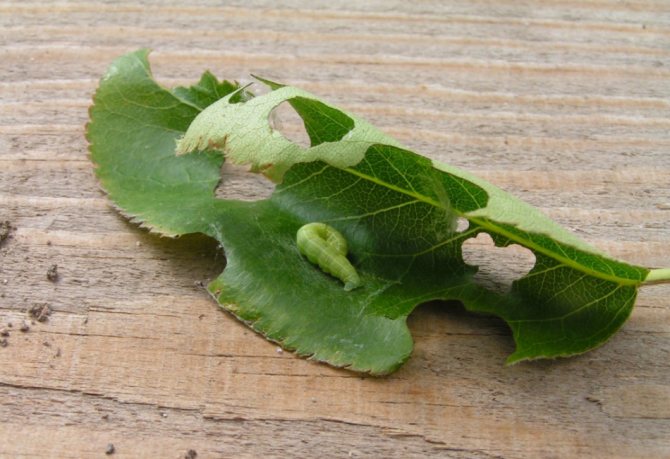

The Leaf Roller and Its Work
The issue of weeds can be solved by mulching the soil or using biological products, timely manual or mechanical removal of all weeds.
Prevention and treatment of diseases of almonds consists in the treatment with fungicides. For this purpose, you can purchase funds "Topaz", "Champion", "Skor", "Fundazol".
Insects that infect almonds are common pests that also take a fancy to other plants in the garden - aphids, leaf rollers, spider mites. If the infection has already occurred, the tree will need to be treated with insecticides. For example, "Aktellik", "Fitoverm", "Tagor" are effective.
If you are already processing almonds, do not be too lazy to spray the neighboring plants, they are most likely either infected from the almonds, or initially acted as a source of infection for it.
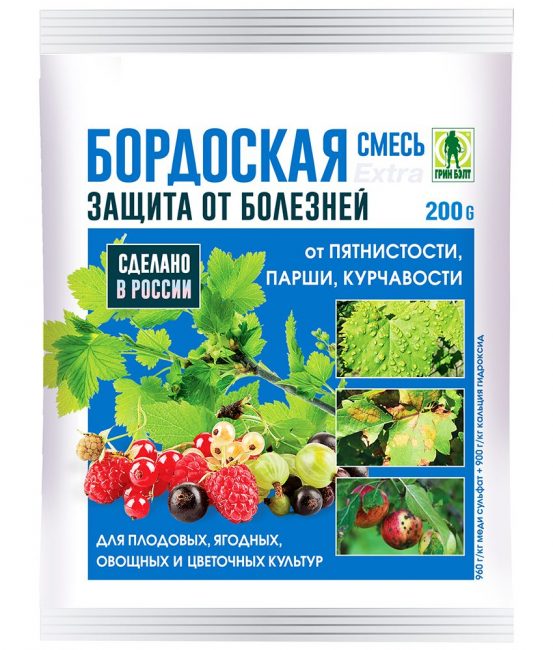

Bordeaux mixture as prevention
1 In early spring, even before the buds begin to bloom, the plant must be treated with a solution of Bordeaux liquid. The solution should be one percent, and it is not recommended to apply it on the opened buds, so as not to damage them. You can also cultivate the land under the tree. Thus, you can get rid of pests that hibernated in the bark or soil of the tree trunk circle.
2 In the fall, when the growing season is over and the plant has lost its foliage, the treatment must be carried out again. This is done in order to eliminate all pests that could hibernate on the tree or in the soil under it.
Instead of Bordeaux spray liquid, you can use chemical or organic preparations similar in principle of action.
Almonds are susceptible to diseases such as scab, gray mold, rust, cercosporosis, and perforation. All of them are characterized by the appearance of various spots on the leaves. Sometimes a gray coating appears. From these diseases, the leaves dry and fall off.
In these cases, the branches damaged by the disease must be removed and burned. Treat the remaining parts of the plant according to the instructions with fungicides, for example, "Champion".
Spider mites, aphids and seed eaters are the most common pests. You can get rid of them with insecticides.
Read more: Plum Tula black variety description
Preventing a disease is always easier than treating it, so preventive measures should not be neglected.First of all, you need to follow the rules of cultivation: ensure adequate watering, remove weeds on time, do not forget about sanitary pruning of branches. Additionally, soil cultivation should be carried out in early spring and autumn after leaf fall. For processing, one percent Bordeaux liquid is used.
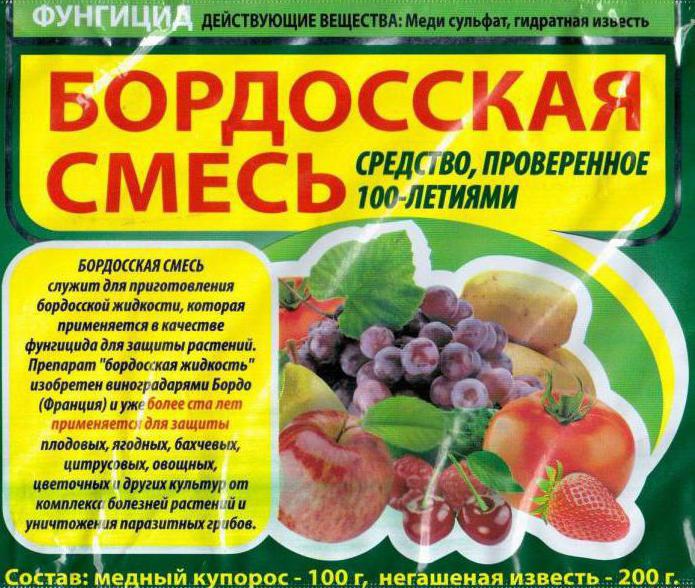

Bordeaux mixture
The almond shrub is susceptible to various diseases that need to be treated:
- gray rot - diseased branches must be cut off after the bush has faded;
- curliness of leaves - do the treatment with Bordeaux liquid, after removing all damaged leaves;
- moniliosis (a fungal disease that affects young weakened shoots) - treatment is carried out in the same way, spraying should be repeated every 15-20 days, for prevention, pruning should be carried out annually after flowering;
- rust - is treated by treating the branches with a colloidal aqueous suspension of sulfur or powder.
The shrub is susceptible to attack by pests, including aphids, plum moth, leafworm. For the destruction of insects, it is recommended to spray with a prepared solution of chlorophos or karbofos.
Decorative properties
The almond bush usually begins to bloom only when the plant reaches the age of four years. It is incredibly beautiful - the shrub is covered with double white or pink flowers of all kinds of shades, which not only decorate the garden area, but also fill it with a wonderful aroma. Its delicate flowers attract honey plants that flock from all over the area.
In landscape design, almonds are used in low varieties, which are ideal for decorating open spaces and rockeries. It is also planted in the background in mixborders, where in the spring months it attracts attention. In summer, it becomes an excellent backdrop for planted perennial flowers.
Types by taste
On this basis, almonds are of three types:
- Bitter. It is not used for food, since it contains hydrocyanic acid - a poisonous substance. Shrubs of such almonds are grown as ornamental plants. The flowers are pink.
- Sweet. The flowering period begins in May. The buds have a white-pink hue. This fruit is good for consumption. Oil is extracted from it, various desserts are prepared. It is an ingredient in many recipes.
- Fragile. It got its name from its thin, fragile shell. These almonds are edible.
Fertilization
Almonds do not require frequent fertilization. While the tree is young, you can feed it 2 times a year - in spring and late autumn. And a newly planted seedling does not need to be fed at all in the first year of life, because it will have enough of those fertilizers that the gardener brought into the planting pit.


In the spring, nitrogen fertilization is necessary
1 In the spring, before the first watering and loosening, nitrogen fertilization is applied to the trunk circle. You can use nitrate for this, at the rate of 20 g of the drug per 1 bucket of water.
2 In the fall, when the site is being digged, a complex of fertilizers is introduced into the almond tree trunk - 1 kg of compost or humus, 20 g of potassium sulphide, 20 g of double superphosphate.
Care features
Almonds need to be cared for in the same way as other decorative representatives of the flora. It needs to be systematically watered, pruned, loosened, fertilized and disinfected from pests.


Almond photo
- Watering. It must be carried out taking into account the fact that the radius around the trunk should not dry out. But if there is too much liquid, then it will stagnate and lead to the formation of rot on the neck of the root. Water should be watered once a week. This will allow the ground 2 centimeters deep to dry out a little. 1 shrub takes 10 liters of liquid.Gardeners advise, after such procedures, to carry out weeding and loosening of the earth near adult shrubs, entering 8-10 centimeters in depth. Young - 5-7 centimeters.
- Fertilizer. In the spring, it is necessary to spread mulch around the trunk using manure or mullein. After a short time, the nutrient solution should be poured. To do this, take water, ammonium nitrate and urea (10 l, 20 g, 10 g). At the onset of autumn, each square meter should be fed with double superphosphate and potassium sulfate (20gr: 2gr).
Preparing for winter
In autumn, seedlings are covered with straw, special covering material or dry leaves about 15 cm above the ground.
It is very important not to let the root collar rot under the snow.
In young plants, the tops of fresh shoots are removed in the summer. The branches are covered with a layer of bark, so the almonds do not freeze in winter. Adult plants do not need any special preparation for winter. The shrub quickly recovers after freezing of the stems.
It is not for nothing that almonds are called decorative - its spreading crown, strewn with flowers, looks solemn. Such a plant is rightfully an adornment of any garden. To grow an ornamental shrub on the site, planting and care must be performed in accordance with all the rules.
Shelter for the period of cold weather is necessary for all plants, regardless of age or where the almonds grow. If the garden is located in the southern strip, insulation for almonds is not so critical, but it is better to keep young seedlings all the same. Of course, if the tree has already "grown" by 4-6 meters, it will not work to cover or insulate its branches, but you can try to take appropriate measures regarding the trunk.
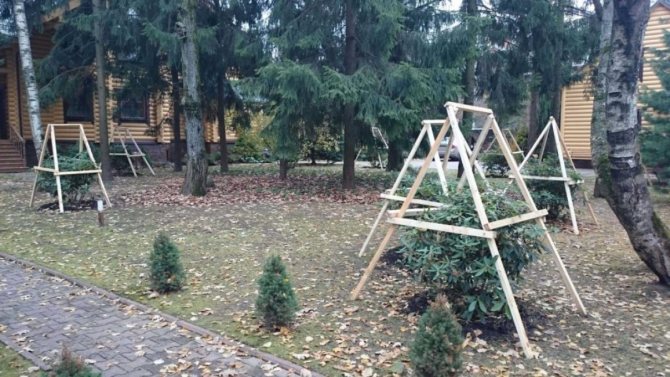

It remains to pull the insulation over the frame - the bush will not freeze
Experts recommend insulating even frost-resistant varieties, such as Stepnoy Almond, aka Nizky, Russian, Bobovnik, or Almond. Some varieties of this frost-resistant species are bushes, not trees, but the taste and benefits of the fruit do not get worse from this.
To protect the plant from the cold, you can take the following measures:
- In early August, remove the apical buds on the shoots. Thus, it will be possible to accelerate the lignification of the shoots and they will better tolerate frosts.
- Cover young (required) and adult (highly desirable) plants 15 cm or more with breathable material - bunches of straw or a bunch of dry leaves. You just need to make sure that the covering material is not sick, since humidity during a thaw or early spring can contribute to the infection of the tree with pathogenic microorganisms. With the first snow, you can begin to form snowdrifts around the tree trunks.
If the crown of young trees consists of relatively bending shoots, they can be collected "in an armful", tied with twine and wrapped in agrofibre. On a more spreading and more elastic crown, you can try to throw lutrasil.
Ledebour
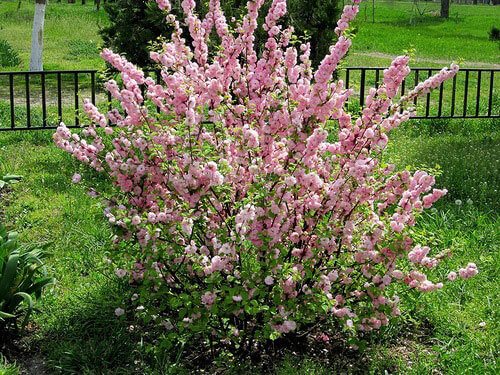

Grows up to 2 meters
Bloom from May to June
First fruits for 11 years
Harvest in August
The fruits of the drupe are tomentose-hairy, up to 4 cm long
Heat-loving, but winter-hardy
A beautifully flowering bush up to 2 meters high with a spreading crown up to a meter in diameter. This almond grows in the foothills of the southwestern Altai. Photophilous, frost-hardy, loves moderate watering. Blooms until leaves appear. It is well pollinated. Almond Ledebour blooms earlier than other species - in early May. Begins to bear fruit upon reaching 10 years.
Flowers of the most popular variety "Fire Hill" are painted in a bright red-pink color, reaching 30 mm in diameter. Form a cushion or spherical crown. Ledebour is able to grow thanks to root suckers.

